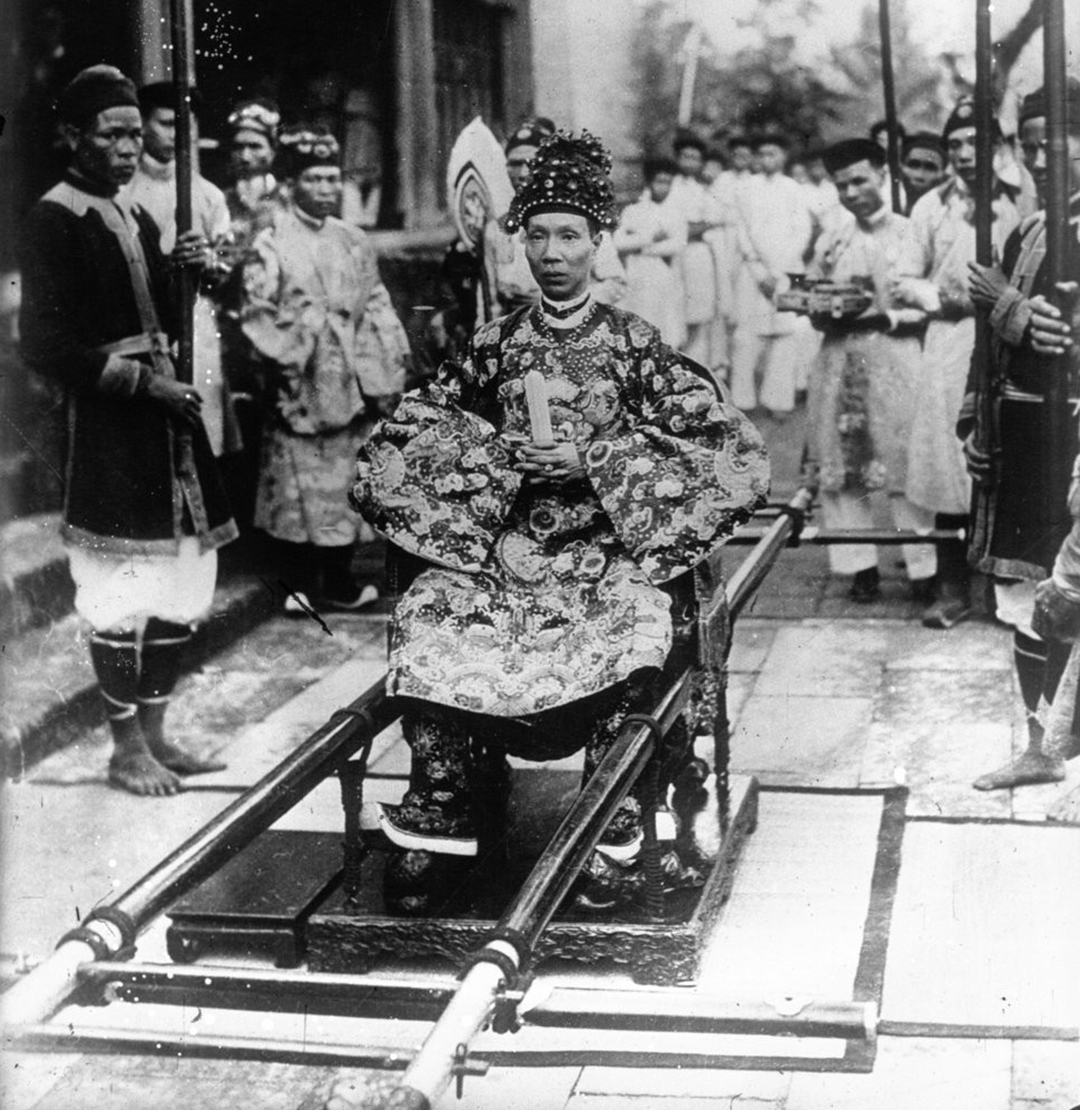
Emperor Khải Định (ruled 1916-1925) presides over a state ceremony (Agence Meurisse press photo)
François Tessan’s article “The Emperor Khai-Dinh,” published in the 1922 volume Dans l’Asie qui s’éveille: essais indochinois (In an Awakening Asia: Indochinese essays), offers a uniquely French colonial view of the penultimate Nguyễn emperor.
It’s in Hue, capital of the “Empire of the Pacified South”, that we have the opportunity to see, in all his Asian splendour, the almighty sovereign on whose countenance at one time no-one could look, except on pain of death. There is surely no city in the whole of Indochina which has retained a more distinct character and a more meditative physiognomy.
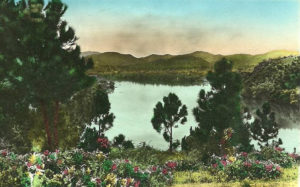
“The Perfume River – view from the famous beauty spot named “Bellevue” (modern Vọng Cảnh Hill)
There emerges from Hue a perfume of supreme philosophy. The emperor Thieu-Tri, in his famous poems, eulogised his 20 main beauty spots, expressing with delicacy the visible and invisible charms of these predestined places.
Over time, Hue has remained a city jealous of its beauty, of its traditions, of its originality, where the “Duc-hoang-de,” the Absolute Master, symbol of divine and humane virtues, reigns according to the principles of the dynasty of the Nguyen.
Not far from the Perfume River, whose waters wander lazily between the rows of flame trees and Japanese lilac which decorate its banks, in the palaces, courtyards and gardens which together form a vast fortress, lives the “Son of Heaven” who is responsible for all Annam. He is doubly hidden from prying eyes, because, apart from the path of the Perfume River, Hue is surrounded on three sides by the Annamite mountain range. Furthermore, this Perfume River does not communicate directly with the sea. At its mouth, a barrier prohibits navigation and the lagoons in which the city is hidden pose no less significant obstacles.
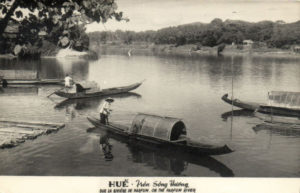
Boats on the Perfume River
When one talks about the “capital,” one should not interpret this word in the strictly Western sense, that is to say, by imagining a city which is imposed on a region by virtue of its geographical position, and which permits easy communication in all directions, facilitating the movement of trade. Hue is above all a place of magnificent retreat, by virtue of the majesty of its surrounding landscape, the scale of its great Citadel, the abundance of its monuments and the peace of its royal tombs, in short, its very mystery. It is a spiritual and political capital that its founders chose for reasons of magical order.
Indeed, they found that here in Hue were concentrated all supernatural influences. Was it not in this place that the energy of the Long-Mach (dragon veins) was discovered, all those centuries ago? To the dynasty of the Nguyen goes the honour of having restored the national tradition, to have infused new life into Annam, having restored strength to that Dragon.
R P Cadière wrote a very nice article on the intervention of spirits in favour of Hue, which pointed out that all of its mountains, woods, rivers are populated by spirits: “Everywhere,” said the missionary scholar, “legends consecrate the stranglehold of the spirits over the capital, and at the same time their beneficent influence, their constant intervention.
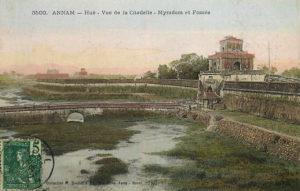
The Citadel in Huế
These benevolent actions by supernatural beings are both the cause and the effect of sentiments which animate the people of Hue towards their heavenly protectors. From the top to the bottom of the social ladder, from the Emperor who makes sacrifices to Heaven at the Nam-Giao esplanade to the humble peasant who makes offerings on festival days, from the profound silence of great palaces to the most squalid hut or the most miserable of boats, days already established by custom or required by the spirits are celebrated. Hearts freeze in awe and respect as incense is smoked, garlands suspended, special dishes offered, rice wine and tea poured, and bodies prostrated.”
Thus are the piety and religion of man reciprocated by the goodness of the gods! Hue is therefore the ideal retreat, where the sovereign is in the best place to contemplate his duties and to cultivate the science of government. Surrounded by conducive terrestrial and celestial influences, he must fulfil his mission so that he becomes the enlightened guide of his people’s souls, “the father and the mother of his subjects.” It’s precisely because Hue offers so many harmonious conditions for the direction of the people of Annam that the Emperor Thieu-Tri proclaimed the superiority of his “marvellous capital” over all other cities.
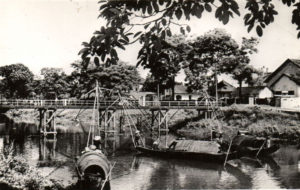
A colonial-era photo of the An Cựu Bridge over the An Cựu River (Canal) in Huế
Taking a walk along the Phu-Cam Canal, around 1km south of the Forbidden City, one will find on the left bank, just before reaching the An-Cuu Bridge, a large native-style portico. Behind this screen of curious aesthetic there is a garden whose exoticism is skillfully disciplined, and, behind the garden, a villa whose mixture of western coquetry and Annamite art cannot fail to surprise the visitor. Before him is the city residence of the present Emperor, His Majesty Khai-Dinh. This is where, very often, the monarch comes to rest from his governmental worries. He likes to retire to this house, not only to escape the strict etiquette of palace and its administrative fatigues, but because the past draws him to this nest of greenery. Part of his youth was spent here. But at that time the house was more modest, comprising only a single-storey building and a small temple for the worship of the ancestors. There were not many servants. The life that he led then was simple and frugal. At that time, when bowing before the tablets of his ancestors, the young Prince Phung-Hoa, now His Majesty Khai-Dinh, doubtless hardly dared think of the day when his name would be transcribed in the Book of Gold and displayed in all the temples of the ancient kings and in the Nam-Giao – the Temple of Heaven.
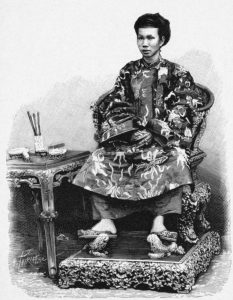
Emperor Đồng Khánh (ruled 1885-1889)
Following what adventures did the young prince take power? This is the most recent history of Annam that I will recount as briefly as possible.
The Emperor Dong-Khanh, who had ascended the throne in 1885 in succession to his brother Ham Nghi, unfortunately ruled only three and a half years. He was a great friend of France and we based our best hopes on his collaboration, but he was taken at the age of just 30. He left two daughters and a son named Buu-Dao, who later took the title Prince Phung-Hoa (“One who transforms into a phoenix”), but was then just three years old and deemed too young to reign. In place of Phung-Hoa – who later became Khai Dinh – the two governments, Annamite and French, chose a prince from another branch of the royal family, Buu-Lan, who took the name of Thanh-Thai (“Absolute happiness and success in everything”).
The two widows of Dong-Khanh – his first and second queens (the latter being the mother Phung Hoa) – retired with their son to the tomb of the late emperor in the Hue countryside. While leading a materially poor and very discreet existence, they did nonetheless give the young prince a strong traditional education and equipped him with the essential notions of writing, reading and morality. They associated these teachings with their cult, following the recommendations of Confucius: “Respect that which the ancestors have respected; cherish what they have loved; serve the dead as if they were alive; honour those buried in their tombs as if they were still present. Is this not the height of filial piety?” They inspired his sense of personal dignity, just as the Book of Verse says: ”Be careful of yourself in your own house. Thus the sage attracts respect, even when he does not appear in public.”
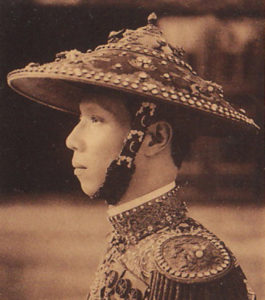
Prince Nguyễn Phúc Bửu Đảo, granted the title Phụng Hóa Công 奉化公 in 1906, eventually succeeded to the throne as the Emperor Khải Định (Huong-Ky Photographie d’art, Hanoï)
When he had reached his 18th year, Phung-Hoa came to live in the small villa at Phu-Cam, about which we were talking earlier. By then he had already acquired a good knowledge of the Chinese classics, and he continued to study them. He was no less interested in the study of ritual questions and of the history of his country. Those who approached him could only praise the dignity of his life and recognise the nobility of his feelings. “Ong-Hoang Ca” (Mr Crown Prince) – as he was called by the natives – showed perfect courtesy towards all. His physical distinction, his soft voice, his agreeable physiognomy, attracted the sympathy of all the people around him. He did not forget that other precept of Confucius: “He who loves his fellow man is truly a man.” And this humane attitude contrasted strongly with the arrogance of certain other members of the royal family. The philosopher noted the sympathetic influence of he who sought the good of those around him: “He shines like the sun and moon. His consistency is comparable to that of the four seasons. His influence recalls that of the spirits. If he anticipates Heaven, Heaven will not oppose him. If he follows Heaven, he will conform to the seasons. And if Heaven does not resist him, still less will men and the spirits resist him!”
The Emperor Thanh-Thai was, in fact, very hostile to this young prince, who, however, did not take umbrage. Thanh-Thai spared him no bullying. Thus, access to the Palace was forbidden to Phung-Hoa during major religious holidays. He was denied all honours. A derisory pension was allocated to him. But Phung-Hoa wisely bided his time, accepting all these miseries. In his villa at An-Cuu, which he decorated himself with exquisite taste, he occupied his time with painting and music.
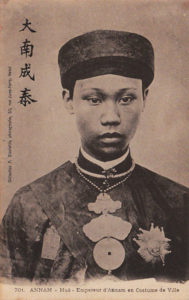
Emperor Thành Thái (ruled 1889-1907)
An artist in every sense of the word, and one of refined sensibility and remarkable manual dexterity, he oversaw everything in his little domain. He excelled at designing his garden, pruning shrubs in the Chinese and Japanese fashion, and cultivating fruit trees. He also knew how to train horses for racing or for pulling carriages. In this way, apart from reading the canonical books and other literary works, he was not embarrassed to fully occupy his leisure time. Perhaps he neglected a little the knowledge of French. But if he didn’t speak our language correctly at that time, at least he was already able to hear and usefully follow a conversation.
Phung-Hoa never made any allusion to the throne of Annam. While remembering that he was the son of an emperor and – despite the material difficulties of his existence – maintaining impeccable elegance, he never ever thought of planning for the future. Like any prudent Annamite, he awaited with patience the course of his destiny.
Thus in 1907, the Emperor Thanh-Thai, worn out and half-mad, abdicated in favour of his son Duy-Tan (“Friend of Reforms”), who was just seven years old. If Phung-Hoa felt some bitterness about that choice, he carefully concealed it and he never abandoned his customary discretion. He did nothing to force events. Those were the events which, in a few years’ time, would pull him from the darkness.
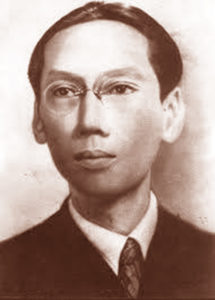
Former Emperor Duy Tân (ruled 1907-1916) in his later years
In 1916, a vague conspiracy was formed in Hue and the feeble Duy-Tan was ready to believe the conspirators. Did he sincerely believe that he could escape the French protectorate by making war, or did he dare to turn his back after having become embroiled in the plot?
Whatever the case, on that evening of 3 May 1916, the young emperor left his palace to lead the insurgents. He was soon joined by our agents, members of the Security Service, who were fully aware of his actions. After an escapade which lasted three days, Duy-Tan was taken back to the capital. On 8 May, Governor-General Ernest Roume arrived from Hanoi. During a meeting he presided over, assisted by Monsieur Charles, Resident-Superior in Annam and attended by members of the Grand Privy Council, it was decided to dethrone Duy-Tan, who was then placed under arrest in the Citadel. It was then decided unanimously – all members belonging to the Thanh-Thai branch of the royal family having been excluded – to call on Prince Phung-Hoa. On 10 May, at the Résidence supérieure, Monsieur Roume had his first interview with the future emperor, who arrived alone, in a pousse-pousse. The prince was so moved that he found it hard to express his thanks to both governments for thinking of him, a person who had never intrigued for power. Head high, he would soon cross the threshold of the palace of his ancestors which he had left 27 years earlier. Phung-Hoa took the regnal name of Khai-Dinh – which means “Era of progress.”
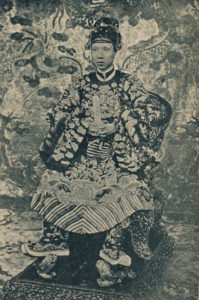
Emperor Khải Định on the throne
On 18 May 1916, a day regarded as favourable by royal astrologers, Khai-Dinh was enthroned amidst official pomp in accordance with ancient rites, and his name was inscribed in the Golden Book, which was opened only at the beginning and end of each reign.
The industriousness of Emperor Khai-Dinh was not long in coming. First, relations with France were cordially restored and a range of planned reforms agreed with the protectorate government. Monsieur Albert Sarraut, and then Monsieur Maurice Long, found in him an enlightened mind ready to work honestly to improve the institutions of empire. Recently, for example, an Indigenous Consultative Chamber for Annam was established.
This young ruler is imbued with a different idea of his function than his predecessors. He claims to draw on the principles that guided the great Nguyen monarchs. The title of “Emperor of the Pacified South” is no empty title. Heavy are the honours and the duties attached to it. It would be incorrect to judge the role of an Asian emperor by comparing it with the role of a Western emperor. Back home, we speak gladly of the despotism of distant monarchs, who often appear to many as autocrats with no limits to their fancy. In reality, if this absolutism is in appearance tempered by no written rule, it is, nevertheless, limited by the duties inspired by Confucian doctrine and the rights of community and family. All Annamite society is steeped in the utilitarian morality which arises from the sacred texts and teachings of the philosophers. The Emperor has custody of this morality, and no upper class may come between him and his subjects. The “Duc Hoang de,” supreme judge, incarnation of the law, speaks and acts on behalf of his nation.
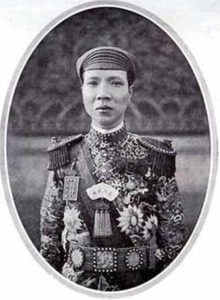
Portrait of the Emperor Khải Định
His intermediaries, the mandarins, divided into nine classes, are not a hereditary caste. They are recruited by examination. Even the poorest children of the rice field, if they are distinguished by their intellectual merits, can become one of the “Four Pillars of the Empire,” that is to say, one of the Four Ministers. It’s from the people that emerge the agents of the all-powerful master. By obtaining university degrees, and through the public demonstration of high moral qualities, they may arrive at the top of the administrative hierarchy. But their descendants have no birth right to special offices of the state, neither do they retain any privileges. They are simply entitled to honours which decrease from generation to generation. And if, after a while, the little sons of those who once occupied the highest offices have not acquired a high personal knowledge and passed the royal examinations satisfactorily, they will fall, lost amongst common mortals.
As for the Emperor himself, if he fails in his mission, if he does not observe the rites, or shows himself unworthy of the honours conferred upon him, he can be excommunicated by the people. Denounced by his subjects, who would consider him as having failed the Mandate of Heaven, he would be driven from the palace. This has happened. Bloody revolts have broken out in history. Thus do dynasties collapse.
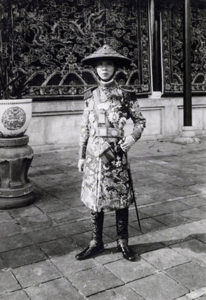
Portrait of the Emperor Khải Định
By the same token, when the emperor governs with prudence, any attack against him is repressed with ferocity. His life and prestige are backed by implacable laws. Not only the man guilty of an attack against the sovereign, but also his family, can be destroyed after appropriate punishment for the misdemeanour.
In the palaces of Hue, etiquette remains extremely severe. The regulations for royal escorts, royal guards and interior police allow no harm whatsoever to the imperial dignity. In the capital itself, we feel awe hovering over everything.
The Emperor Khai-Dinh has neglected nothing to enhance the lustre of this protocol and to revive past traditions which combine with contemporary ideas to create an elegant modernism. His artistic tastes have also been imposed liberally since his accession. Hardly was he installed as emperor than the private apartments of the palace, the Palace of the Queen Mothers, outbuildings and courtyards, gardens and temples whose maintenance had previously left much to be desired, were rehabilitated. We have witnessed a complete transformation and a rebirth of the Annamite aesthetic. The tomb of Dong-Khanh was a particular object of devotional attention for Khai-Dinh, who has never failed in the precepts of Confucianism. The monarch has also chosen, with the help of his astrologers and geomancers, the locations of his own grave and of the tombs of the Queen Mothers – which in Annam is a high mark of solicitude and love. His generosity has been no less apparent with regard to Thanh-Thai and the princes and princesses of that family, which, however did not cease to create setbacks for him. The Emperor Khai-Dinh did not want to remember the offences committed against him when he was Prince Phung-Hoa.
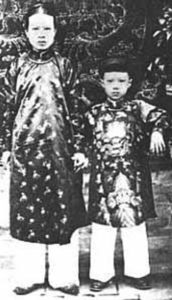
Empress Từ Cung with her son Nguyễn Phúc Vĩnh Thụy (the future Emperor Bảo Đại)
A single son -the prince Vinh-Thuy – has been born to the sovereign of Annam. This prince, aged nine, accompanied his father to France in May 1922. He has since remained in Paris for his education and upbringing. Monsieur Charles, former Resident-Superior in Hue, has been made responsible for introducing him to Western culture. No more complete proof of the attachment of His Majesty Khai-Dinh to France may be provided to us than his desire to see his child deeply connected with us through spiritual and cultural ties.
The very fact that the emperor himself left his kingdom to pay a visit to the protecting nation appears no less significant. It is unique in history. On that occasion, His Majesty Khai-Dinh spoke in the language of his country’s scholars about the benefits of France’s involvement in the Far East.
“Yours,” he declared, “is a great living intellect, active and creative. We, on the other hand, are a meditative and calm intellect which revels in the pious contemplation of dead things. Still, you have come, by way of the mind and the heart, to respect our past and make it serve the glorious edification of your future. Thanks to your supreme and subtle intelligence, as far as the Annamites are concerned, you have denied nothing, despised nothing. That is why I have come across the oceans to learn from you, from your clear genius, the great conciliatory lesson that will unite forever the fate of my people to the destinies of sovereign France.”
What comment can one add to such a tribute?
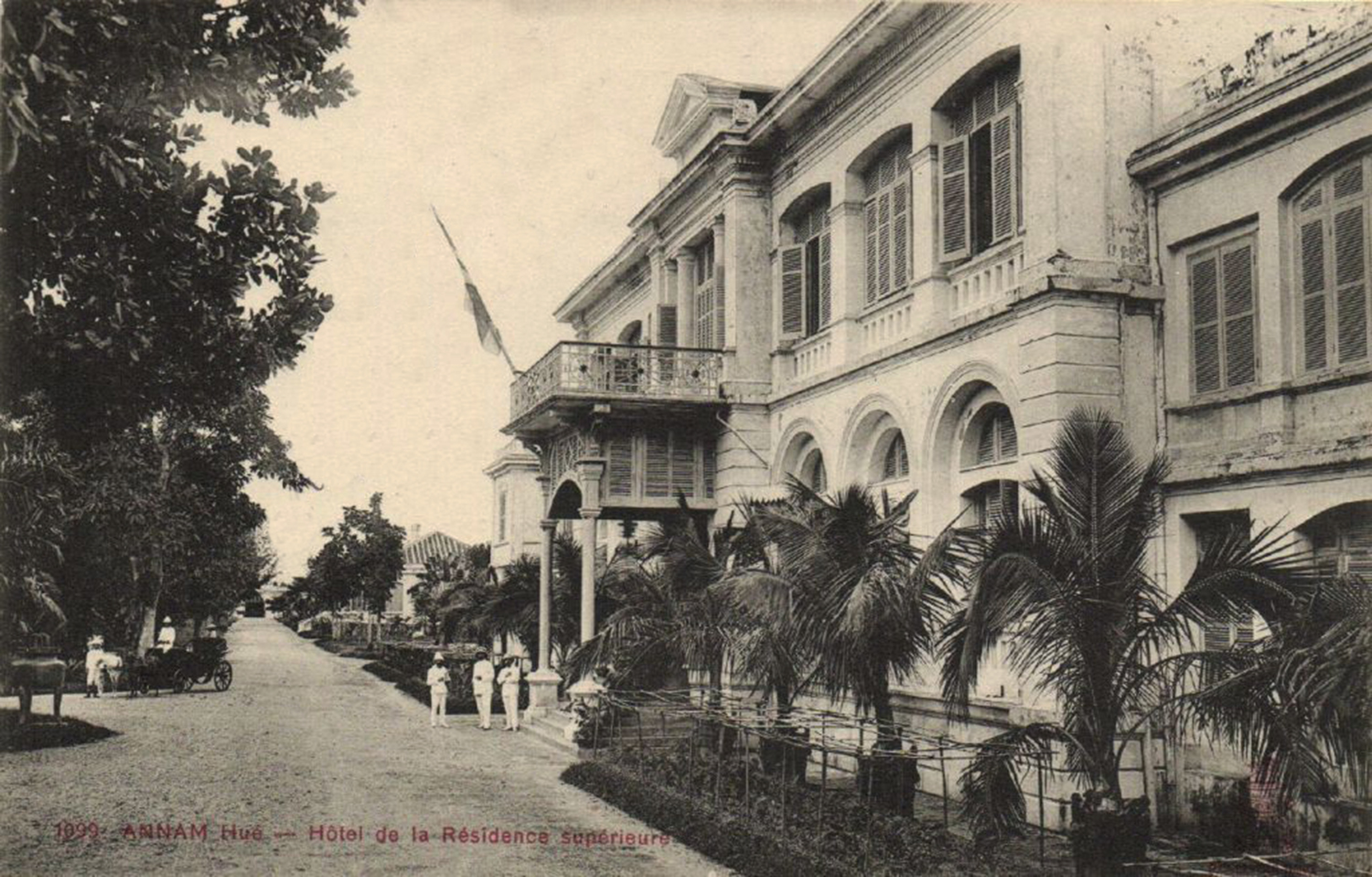
The French Résidence-Supérieure in Huế
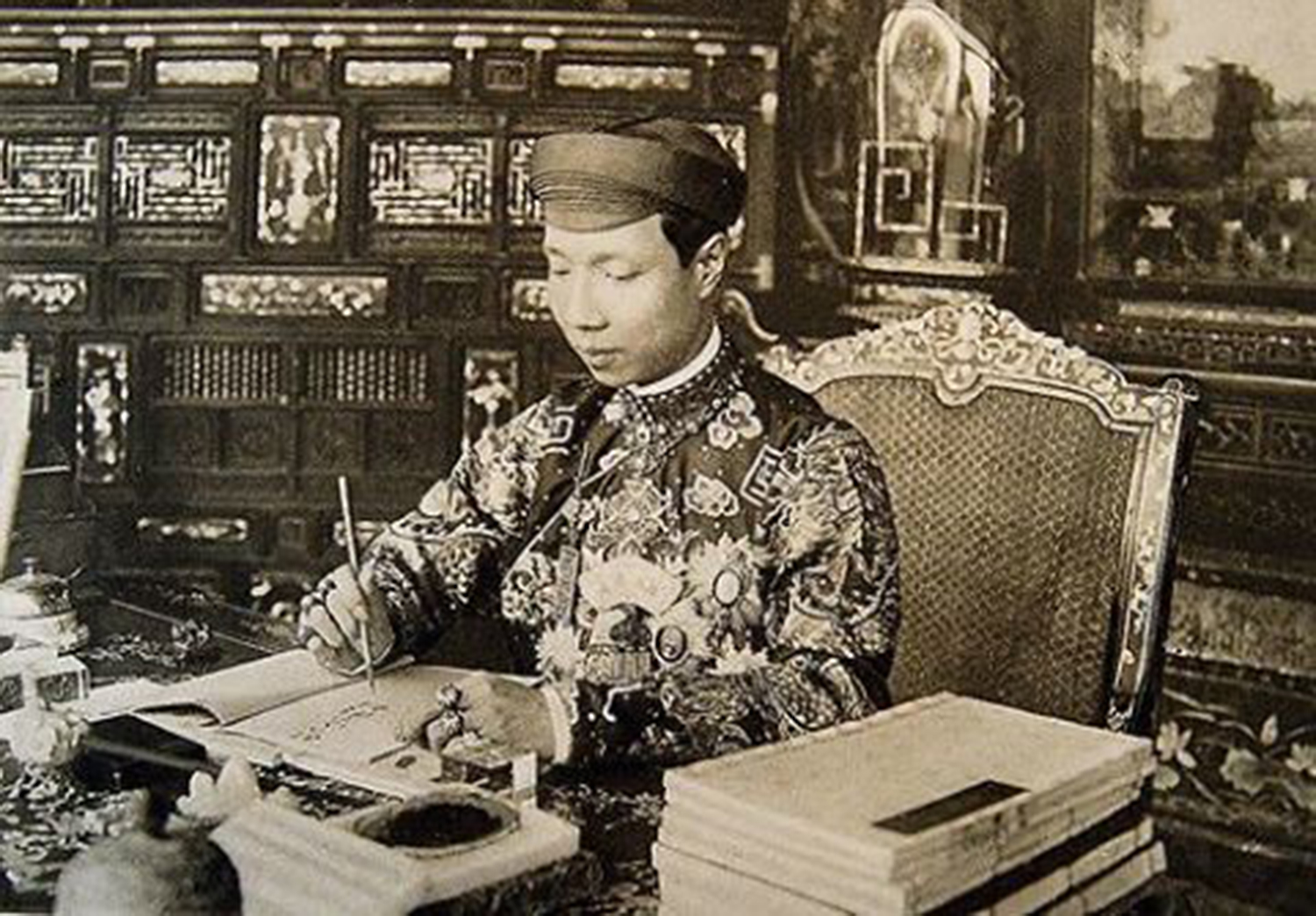
Emperor Khải Định at his desk (Huong-Ky Photographie d’art, Hanoï)
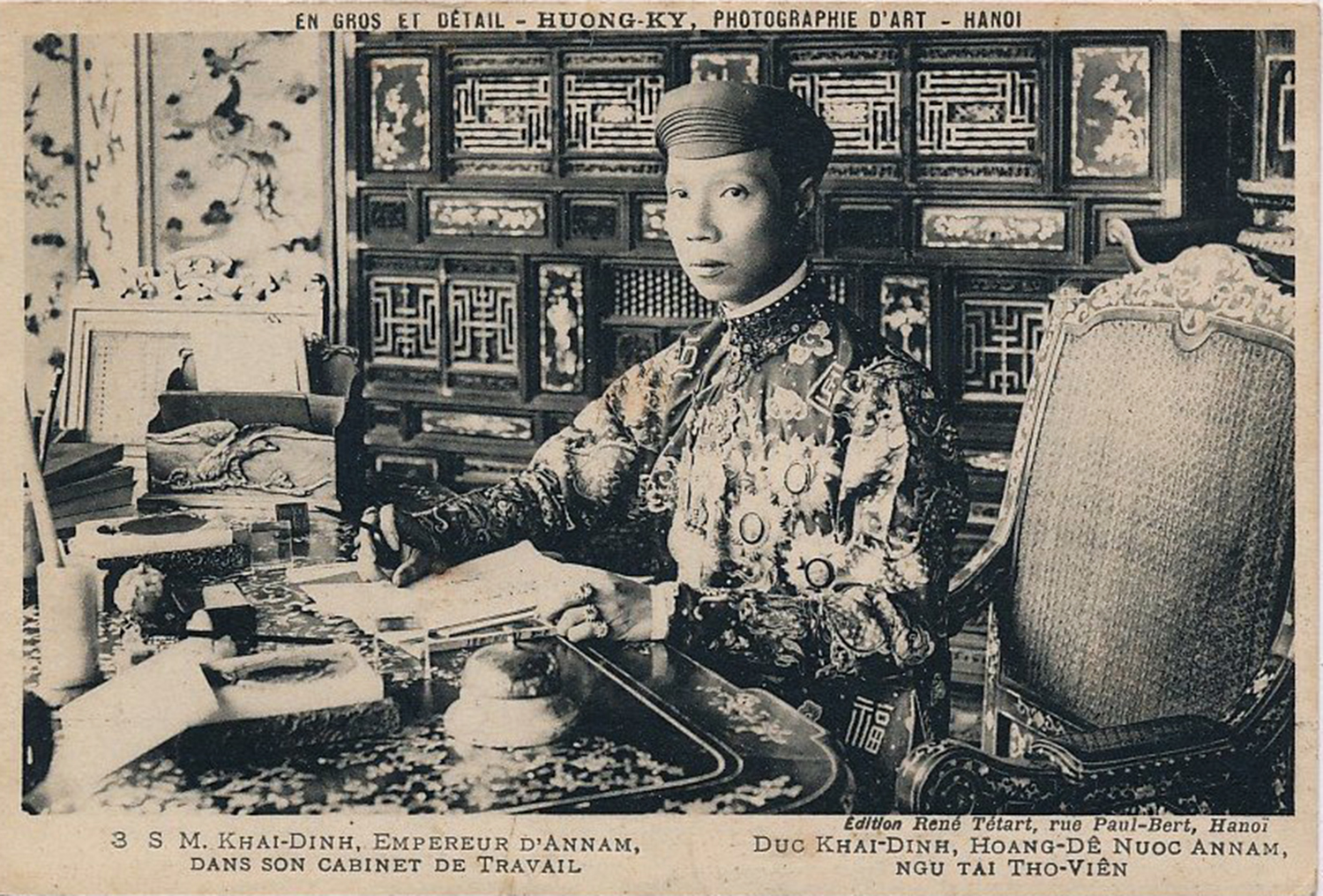
Emperor Khải Định at his desk (Huong-Ky Photographie d’art, Hanoï)
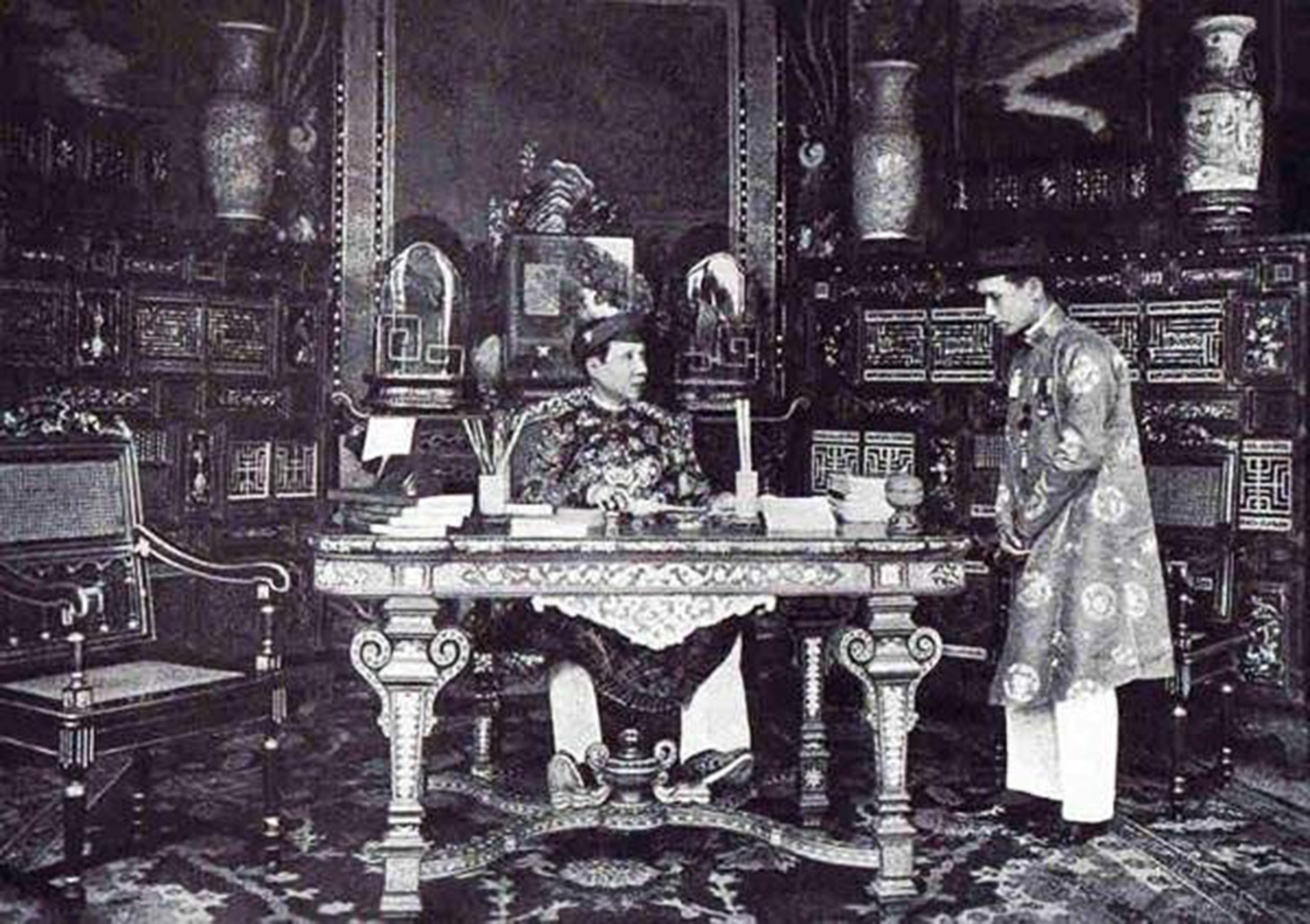
Emperor Khải Định at his desk (Huong-Ky Photographie d’art, Hanoï)
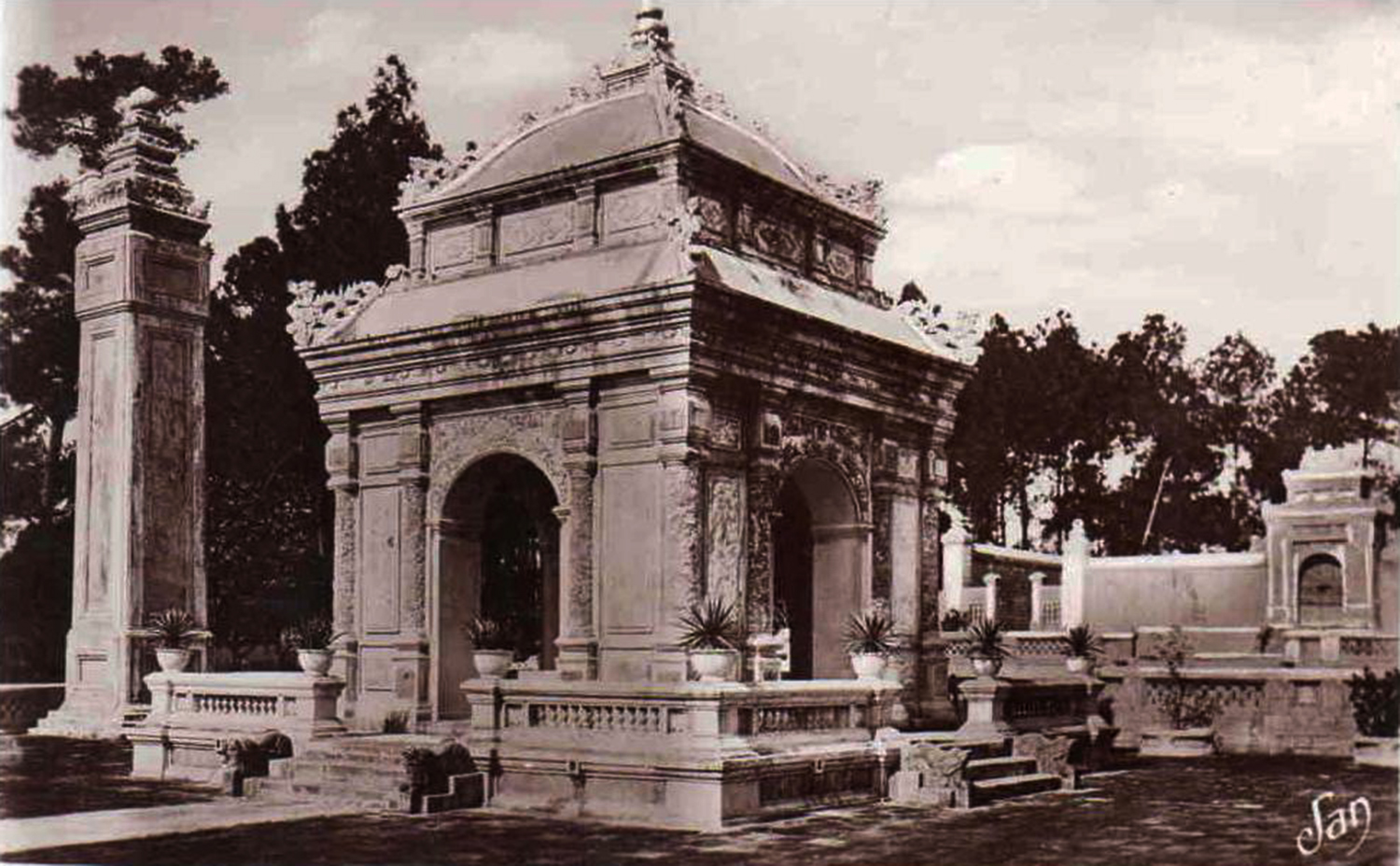
The Đồng Khánh Mausoleum was remodelled by Emperor Khải Định
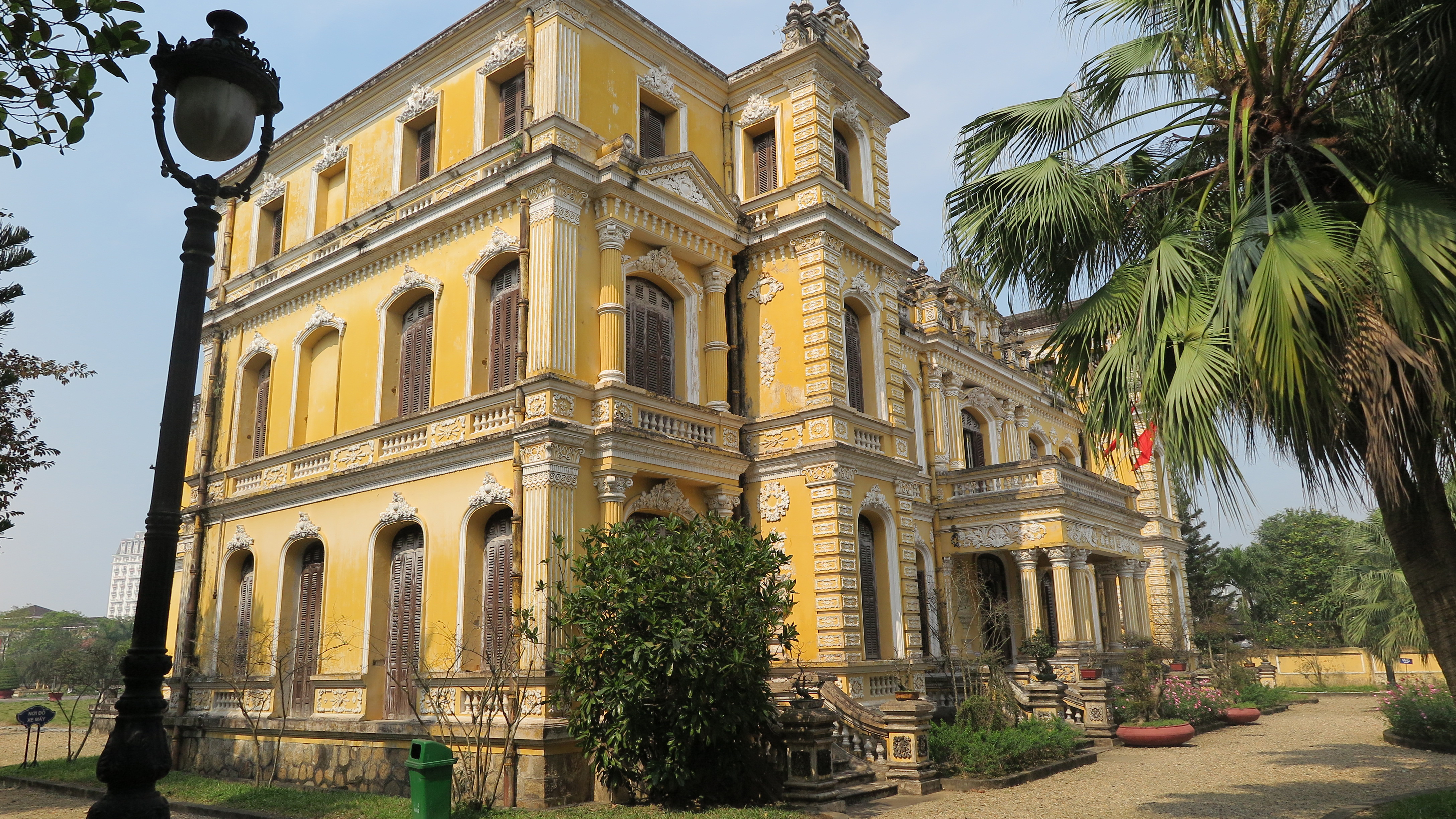
The An Định Palace, built in neo-classical colonial French style on the site of the former Phủ Phụng Hóa in 1917 and renovated and enlarged between 1917 and 1919
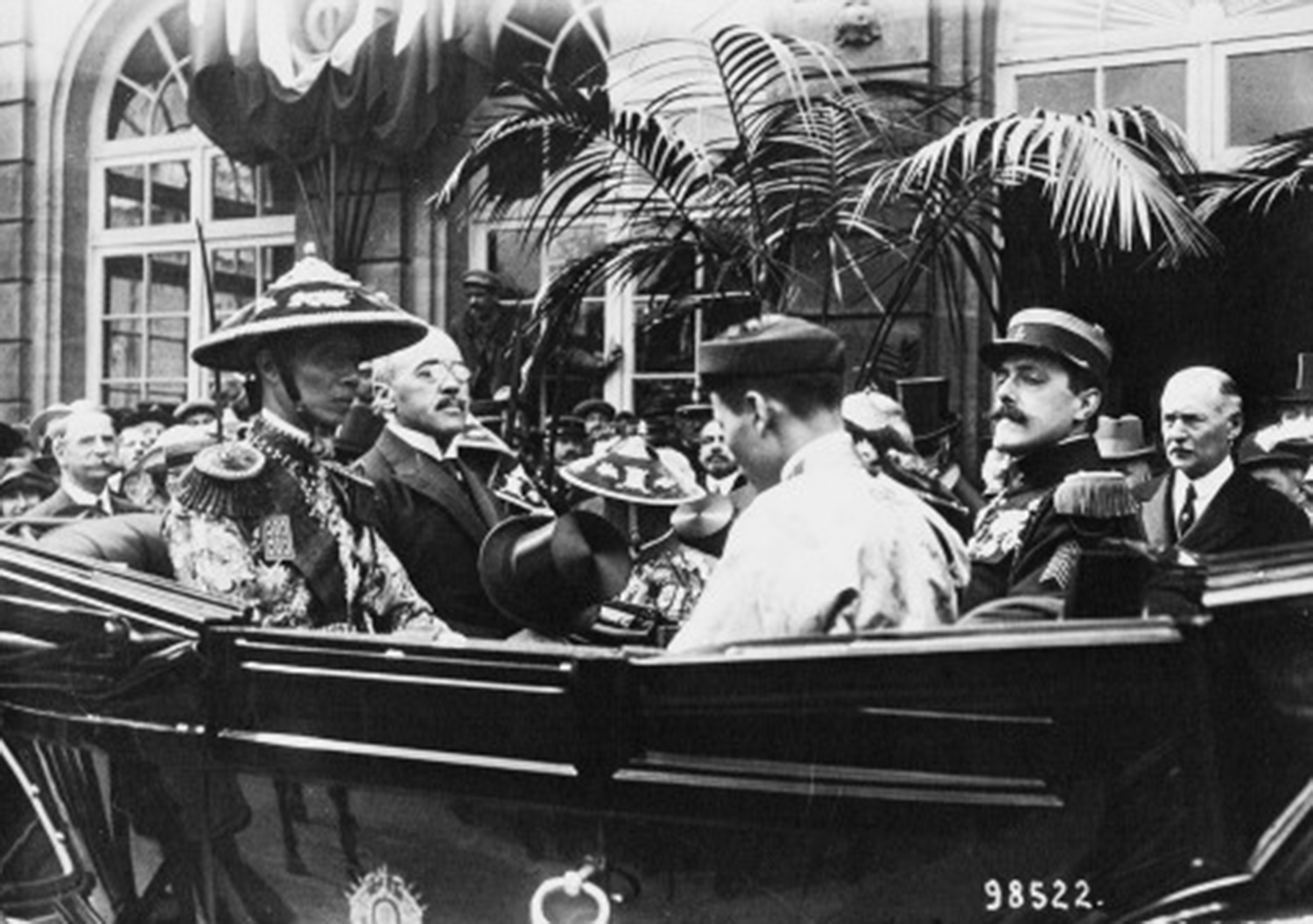
Emperor Khải Định visited Paris in 1922
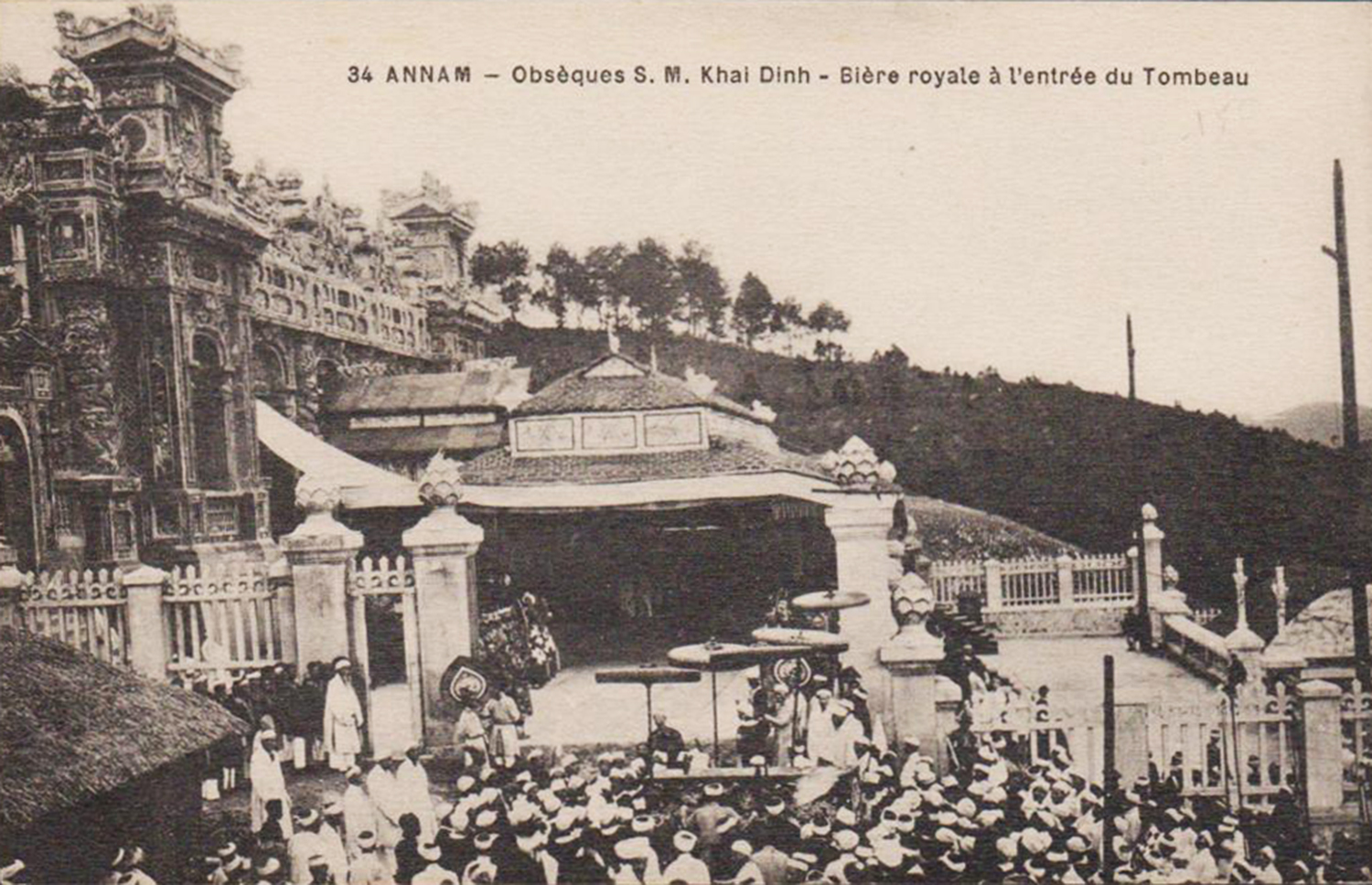
The funeral of Emperor Khải Định
Tim Doling is the author of the guidebook Exploring Huế (Nhà Xuất Bản Thế Giới, Hà Nội, 2018).
A full index of all Tim’s blog articles since November 2013 is now available here.
Join the Facebook group page Huế Then & Now to see historic photographs juxtaposed with new ones taken in the same locations, and Đài Quan sát Di sản Sài Gòn – Saigon Heritage Observatory for up-to-date information on conservation issues in Saigon and Chợ Lớn.

